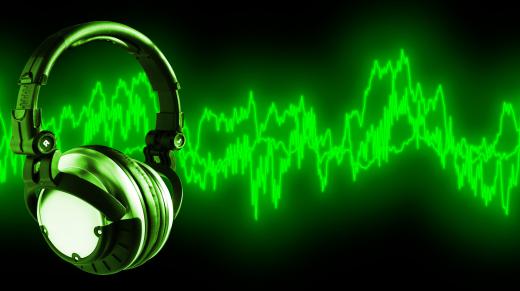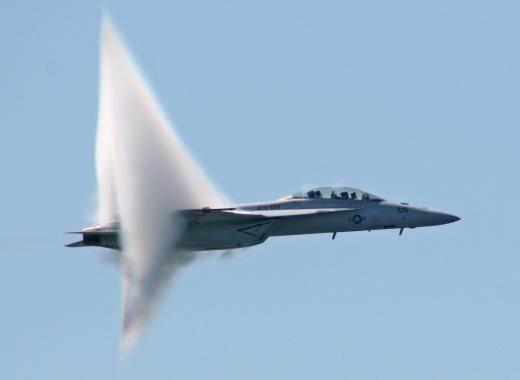What is a Sound Wave?
 Mary McMahon
Mary McMahon
A sound wave is a type of pressure wave caused by the vibration of an object in a conductive medium such as air. When the object vibrates, it sends out a series of waves which can be interpreted as sound. For example, when someone hits a drum, it causes the membrane of the drum to vibrate, and the vibration is transmitted through the air, where it can reach the ear of a listener. Vibrations travel at different speeds through different media, but cannot travel through a vacuum. Aside from being used for communication, sound waves are employed to provide images of inaccessible objects and structures, in oceanic surveys, and in geology and seismology.
Types of Wave

Sound travels through gasses, liquids, and solids as longitudinal waves. This means that the compression of the medium is in the same direction as that in which the sound is traveling. In solids, and at the surfaces of liquids, vibration can also travel as transverse waves. In these, the compression is at right angles to the direction of motion.
The Speed of Sound

The speed at which sound travels depends on the density of the medium through which it is traveling. It travels more quickly through denser media, and is therefore faster in solids than in liquids, and faster in liquids than in gasses. In familiar, earthly, conditions, the speed of sound is always enormously less than that of light, but in the super-dense material of a neutron star, it may come quite close to light speed. The difference in speeds through air is demonstrated by the delay between a flash of lightning and the sound of thunder for a distant observer: the light arrives almost instantaneously, but the sound takes a noticeable amount of time.

The speed of sound in air varies with pressure and temperature, with higher pressures and temperatures giving higher speeds. As an example, at 68°F (20°C), and standard sea-level pressure, it is 1,126 feet per second (343.3 meters per second). In water, the speed is again temperature dependent; at 68°F (20°C) it is 4,859 ft/sec (1,481 m/s). The speed in solids is very variable, but some typical values are 13,700 ft/sec (4,176 m/s) in brick, 20,000 ft/sec (6,100 m/s) in steel, and 39,400 ft/sec (12,000 m/s) in diamond.
Wavelength, Frequency, and Amplitude
Sound can be described in terms of wavelength, frequency and amplitude. The wavelength is defined as the distance it takes for a complete cycle to be completed. A complete cycle moves from peak to peak or trough to trough.

Frequency is a term used to describe the number of complete cycles within a set period of time, so shorter wavelengths have higher frequencies. It is measured in hertz (Hz), with one hertz being one cycle per second, and kilohertz (kHz), with one kHz being 1,000 Hz. Humans can hear sounds ranging from 20 Hz to about 20 kHz, but vibrations can have much lower, or higher, frequencies. The hearing of many animals extends beyond the human range. Vibrations that are below the range of human hearing are called infrasound, while those above that range are known as ultrasound.
The pitch of a sound depends on the frequency, with higher pitches having higher frequencies. The amplitude is the height of the waves and describes the amount of energy carried. High amplitudes have higher volumes.
Wave Phenomena
Sound waves are subject to many of the phenomena associated with light waves. For example, they can be reflected from surfaces, they can undergo diffraction around obstacles, and they can experience refraction when passing between two different media, such as air and water, all in a similar manner to light. Another shared phenomenon is interference. When sound waves from two different sources meet, they can reinforce one another where the peaks and troughs coincide, and cancel one another out where peak meets trough, creating an interference pattern, with loud and quiet areas. If the vibrations have different frequencies, this can create a pulsed effect or a “beat” in the combined sound.
Applications
Sound waves have many applications in science and medicine. Ultrasound imaging can be used to investigate medical problems and carry out important checks. One well-known application is an ultrasound scan, used to produce an image of an unborn child, in order to check on its health where an X-ray would not be safe. Sound pulses, known as sonar, can be used to map the ocean floor by precisely measuring the time taken for an echo to be received.
In seismology, the inner structure of the Earth can be investigated by observing the propagation of sound waves. Since transverse waves cannot travel through liquids, this technique can be used to map out areas of molten rock under the surface. Typically, sound is generated by an explosion, and the vibrations are picked up at various distant points, having traveled through the Earth. By examining the pattern of transverse waves — known as “s-waves” in this context — and longitudinal waves — known as “p-waves” — an accurate three-dimensional map can be built up, showing the distribution of solid and molten rock.
AS FEATURED ON:
AS FEATURED ON:














Discussion Comments
I m asking for help as I see knowledgeable posts on the subject. I 'm trying to find out if there is a system or the technology, to create like a wall of air, or waves to isolate two rooms, soundwise.
It's strange, but picture a restaurant with noisy service area, which is a pain for some tables. It doesn't seem to exist -- only solid insulation. Maybe I read too much Sci-Fi. Could it be done, do you think?--
Nicolas, London
Can the vibration caused by the element causing the noise be used to provide electricity?
@ GlassHouse- I could think of one application that would make this worthwhile. High frequency sound wave technology could be used to transform waste heat from nuclear power plants into usable energy. It is essentially using the laws of thermodynamics to create usable chaos. Light and heat are some of the waste forms of energy created by the transfer of another form of energy into sound waves. If you were able to use all of the waste heat generated by nuclear cooling towers, you could then turn this into usable energy. An acoustic engine could be used to turn this waste heat into electricity by creating a voltage out of the sound waves emitted from high frequencies (frequencies beyond our range of hearing).
Think of it like reversing one of those acoustic pest repellents. Instead of using the electricity to produce the ultra high pitch sounds, you would use the sounds to produce electricity. Ultimately, this would increase the efficiency of the nuclear power plant.
@ Lokithebeak- I don't think that generating electricity would be very practical using sound energy. I once read an article in the Guardian about using sound to generate heat waves, and it would take almost 10 years of continuous yelling to produce enough heat to make a cup of coffee. The point being that there are much more efficient ways to produce energy. The amount of energy produced form sound is much less than the amount required to make the sound.
Here's another example, to shatter a window in an enclosed vehicle with low frequency sound waves, it would take at least 5,000-10,000 watts of electricity. I couldn't see any situation where one would want to expend more energy than sound creates just to create less energy.
When sound travels does it produce energy? Could "sound energy" be used for electricity like wind energy is?
Post your comments